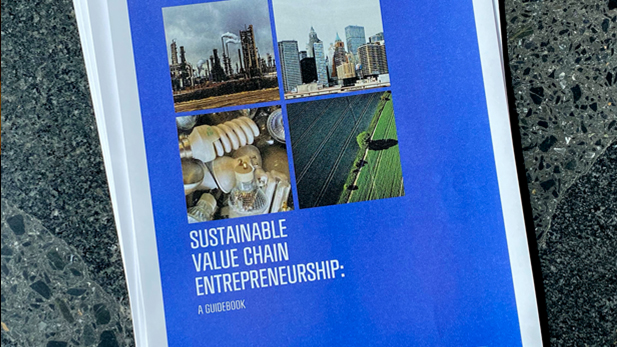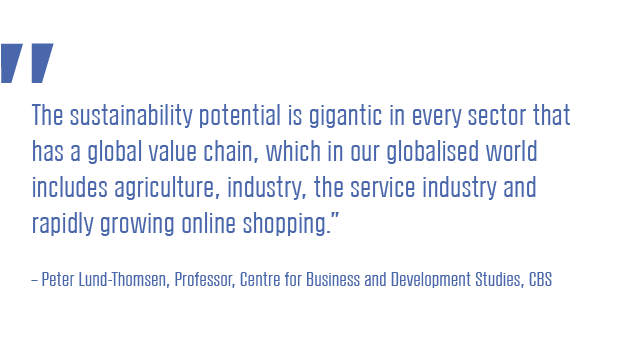Can sustainable innovation in the value chain lead to greenwashing?

SUMMARY
The CBS publication “Sustainable Value Chain Entrepreneurship: A Guidebook” sheds light on the challenges and risks that global corporations and brands meet – and expose themselves and consumers to – when working with sustainability in their value chains. This guidebook focuses on the positive potential for the development of the climate globally and the journey toward a more sustainable world for all, in contrast to greenwashing, which is nothing more than smoke and mirrors designed to deceive consumers. The guidebook also introduces an innovative concept that calls on corporations to act entrepreneurially and to invent new ways of working with sustainable value chain management to a much greater extent than today – instead of leaving it to suppliers to fund all new investment in sustainability initiatives. The guidebook is targeted for teaching at the master’s level and as input for debate and reflection at companies, in organisations and among politicians.
The CBS publication “Sustainable Value Chain Entrepreneurship: A Guidebook”, which received support from the Danish Foundation for Entrepreneurship, sheds light on the challenges and risks that global corporations and brands meet – and expose themselves and consumers to – when working with sustainability in their value chains.
Behind the publication are CBS visiting researcher Dr Rachel Alexander and Professor Peter Lund-Thomsen from CBS’ Centre for Business and Development Studies. Lund-Thomsen does research on sustainable value chains with a focus on corporate involvement in developing countries, including their contribution to sustainable global development.
LACK OF SUBSTANCE
Lund-Thomsen’s research shows that, even though large corporations, for example H&M, IKEA and BESTSELLER often tout their innovative value creation focusing on sustainability, it can lack real substance.
“Sustainability initiatives across value chains and continents can be important contributions to the overall development of the climate and sustainability. They can also be greatly abused by companies, however, to create marketing spin that greenwashes their practices, making them appear as green saints despite a relatively flimsy effort. And that’s clearly a dilemma,” asserts Lund-Thomsen.
The guidebook sheds light on this dilemma and the associated pitfalls. For example it asks whether a company can describe itself as sustainable if its business practices are based on a markedly unequal distribution of profits, or if the work causes the people who make the products to become ill.
NEW SUSTAINABILITY CONCEPT
The guidebook also introduces a new concept for sustainable entrepreneurship in the value chain. As Lund-Thomsen explains:
“When analysing and managing a sustainable value chain, companies have not normally been overly concerned with entrepreneurship. That is, with the development of new sustainable products, business opportunities or concepts. In the guidebook we introduce the idea that companies themselves must begin to act entrepreneurially and to invent new ways of working with sustainable value chain management and thus help to bring us through the climate and sustainability crisis.”
The authors of the guidebook argue that if more long-term sustainable solutions are to be developed, new ground-breaking concepts and technologies will have to be created. This can be done by companies themselves innovating to solve sustainability issues down the entire value chain.
“In the clothing and textile industry, for example, clothes can be disassembled and the threads extracted to make new products. Another possibility is to change the forms of production so that, for example polluting diesel engines in factories in Bangladesh are replaced with a sustainable energy supply from locally adapted wind turbines,” explains Lund-Thomsen, adding that these two examples are diametrically opposed to the current buy-and-throw-away mindset, where clothing is manufactured as cheaply as possible, often without regard to employees or the environment.

SUSTAINABILITY AT ALL LEVELS
The value chains of large corporations often span three or four continents and possess far more links than most people are aware of. Let’s take an ordinary cotton t-shirt as an example, suggests Lund-Thomsen:
“The cotton is likely grown and harvested in West Africa. After being picked the raw material from the cotton plant is sent to western India for further processing and the production of thread, which is then sent to Bangladesh, where the fabric is manufactured and dyed. The fabric is then transported to factories in Bangladesh or China, where the clothes are sewn. The finished items are sent to central warehouses across the globe before being distributed to stores and consumers.”
Lund-Thomsen’s point is that sustainability innovation must occur at all levels of the value chain – from the cotton fields to the shop – before it is possible to declare the finished product sustainable. It is a question of ensuring, for instance the sustainable cultivation of cotton without pesticides and the use of child labour, of implementing a sustainable energy supply and of minimising work accidents by automating some aspects of production at thread and sewing factories, where child labour is also an issue. Moreover it is also matter of the immense amount of water and chemicals consumed at the factories that manufacture and dye the fabric. At the same time, sustainable transport between the many links in the value chain must also be ensured.
(DIS)HONEST COMMUNICATION
The guidebook’s co-authors also focus on corporations from a variety of industries that centre on sustainability, taking a closer look at the innovations that they implement across their value chains. In addition they examine the possible roles that individual suppliers can play in relation to sustainable innovation processes.
The authors are furthermore interested in whether and, if so, how trade unions, states and NGOs, in collaboration with companies and suppliers, can help influence the value chain in a sustainable direction in terms of, e.g. labour rights and environmental issues. The guidebook provides examples of NGOs entering into partnerships with local suppliers and global corporations to impart general and local knowledge that enables the development of new production methods. As far as states are concerned, there are examples of how they both support and undermine sustainable innovation at the supplier level.
There is by all means already a focus on sustainability in the value chain. According to Lund-Thomsen, however, there is a gap in relation to the willingness of corporations to link sustainability and innovation in the value chain – and take the lead themselves. As a researcher he has seen numerous examples of companies inflating a pilot project to represent a huge sustainability effort when in all actuality it does not affect their procurement practices in any way. This may, however, be impossible for consumers to gauge because, to reap the benefits of riding the green wave while protecting their reputations, companies insert layers of communication that hide the bad stories further down the value chain.
“The honest approach for companies would be to present their business practices for purchasing goods and services and to tell the outside world that their sustainability agenda is either separate from or integrated into its procurement practices. Research shows that substantial progress is only made if sustainability is fully integrated into these practices,” explains Lund-Thomsen.
He believes that sustainable value chain innovation is a crucial factor in the green transformation and the effort to create a more sustainable world, including the ability of Denmark and the EU to reach their goals to reduce CO2 emissions and to live up to the United Nations Sustainable Development Goals, which deals with sustainability in a broad sense and also addresses people’s work and living conditions.
“The sustainability potential is gigantic in every sector that has a global value chain, which in our globalised world includes agriculture, industry, the service industry and rapidly growing online shopping,” states Lund-Thomsen.
TEACHING AND DISCUSSING
According to Lund-Thomsen “Sustainable Value Chain Entrepreneurship: A Guidebook” is primarily intended as teaching material at the master’s level in Denmark and internationally. The aim is to incorporate the guidebook’s message into the reservoir of knowledge students bring with them when they enter the labour market. It is also his hope that the guidebook will contribute to the raising debate both politically in organisations such as the UN and OECD and internally in companies.
“We will present the guidebook to, for instance the Danish Ethical Trading Initiative and its sister organisation Ethical Trading Initiative in England, which represents large and medium-sized companies, NGOs, trade unions and government representatives in the two countries. It is my hope that it will raise awareness of the various perspectives on sustainable value chain innovation and become part of the reflection process for all involved parties.”
WOULD YOU LIKE TO KNOW MORE?
Please do not hesitate to contact CBS Professor Peter Lund-Thomsen for more information at: pl.msc@cbs.dk
You are also most welcome to contact co-author Dr Rachel Alexander, senior research associate, University of Johannesburg and visiting researcher, CBS Centre for Business and Development Studies at: ral.msc@cbs.dk
Download “Sustainable Value Chain Entrepreneurship: A Guidebook”: https://910bcd19-158c-4be0-9bcc-00cf8bb356dc.filesusr.com/ugd/3f70d0_c8a...